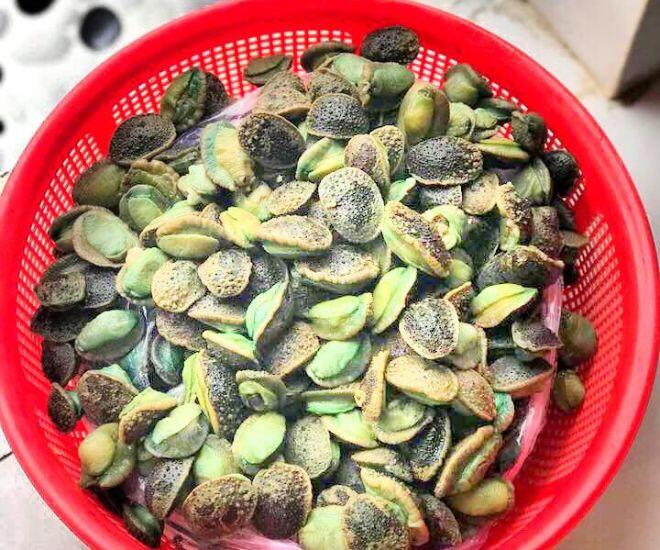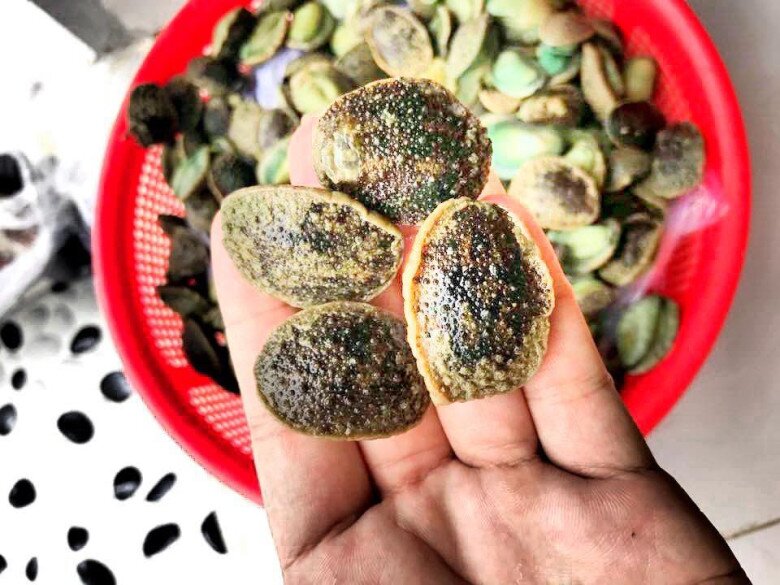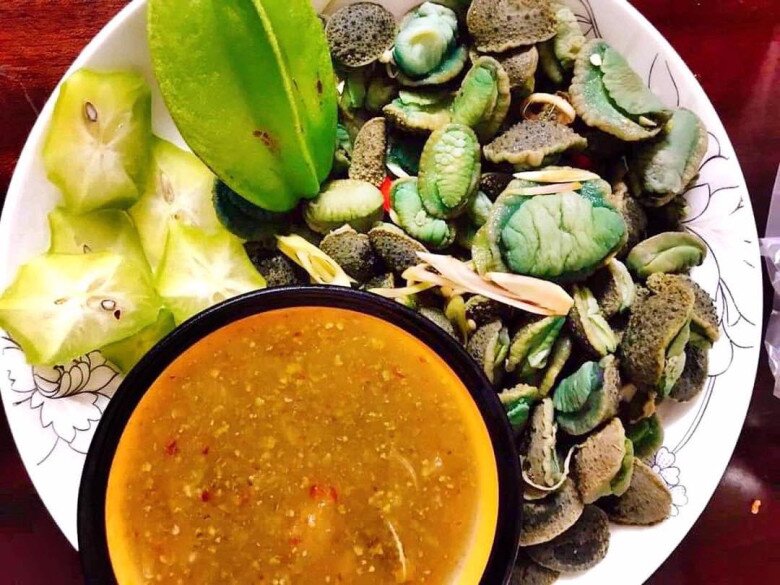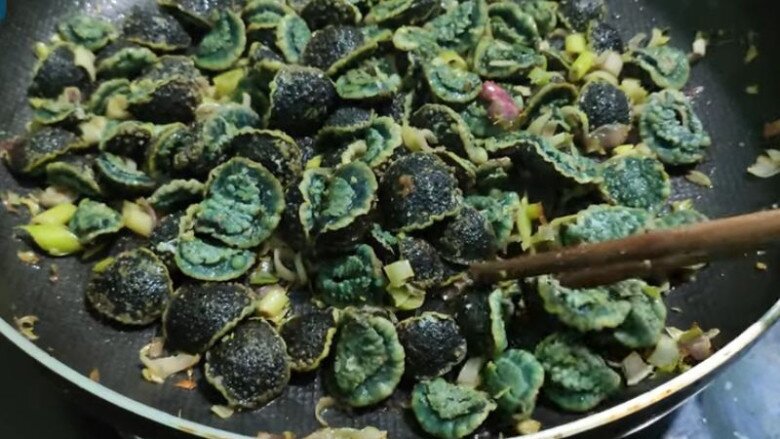The con lu, commonly known by its colloquial name, ‘con ba chan’ or ‘con xu xi’, is a unique mollusc devoid of a hard outer shell. At first glance, the con lu resembles a small turtle with its yellow belly and brownish-grey back. Its distinctively rough and bumpy skin, along with its ability to secrete a slimy substance, makes it stand out. The size of these creatures varies, ranging from thumb-sized to those as large as duck eggs, depending on their habitat and age.

The con lu is predominantly found in brackish riverine areas of Thanh Hoa, particularly in the districts of Hoang Hoa, Hau Loc, Quang Xuong, and Nga Son. They favor habitats such as river inlets, grass fields with năn and lác grasses, and muddy riverbanks.
Notably, the con ba chan is most abundant and of the finest quality in areas such as Thuan Loc and Van Loc in Hau Loc, Nga Thai, Nga Dien, and Nga An in Nga Son, and Quang Nham and Quang Thach in Quang Xuong. However, when it comes to the “capital” of the most delectable con lu, one must mention Bai But on the Dang River. This large riverbank, rich in alluvium, where brackish and saltwater meet before flowing into the Lach Truong estuary, provides an ideal environment for the con lu, imparting a distinctive and memorable flavor.
The color of the con ba chan blends seamlessly with the soil of the riverine areas, providing effective camouflage. During the day, they hide beneath the grass, in crevices, or in the footprints of cattle or humans to avoid detection. Only when night falls and the tide recedes do they emerge to feed. Notably, on rainy days or after a downpour, more con lu venture out in search of food, providing locals with ample opportunities for harvesting them.

Despite being a rustic delicacy, preparing con lu requires meticulousness and effort. Even after being caught, con lu can survive for up to two weeks, making transportation and storage convenient.
However, the most challenging part is cleaning them. As they bury themselves in muddy terrain and secrete a thick layer of mucus for protection, cleaning them is a time-consuming and technical process. Locals typically place the con lu in baskets along with sand, ash, and quicklime, then vigorously scrub them until the mucus is completely removed. This process continues until the con lu’s body turns chicken-liver color. They are then rinsed with saltwater and gutted, ready for cooking.
The people of Thanh Hoa have created numerous mouthwatering specialties from con lu, enriching the local culinary landscape. Popular dishes include steamed con lu dipped in ginger fish sauce, sweet and sour con lu stir-fry, and con lu stir-fried with lemongrass and chili. Among these, the steamed con lu with ginger fish sauce is considered the ultimate way to savor the natural, delectable, and buttery flavor of fresh con lu. For con lu that has been frozen, stir-frying is often preferred to ensure freshness and a delightful chewy texture.

Today, con lu dishes are not only confined to family meals but have also made their way into the menus of many restaurants and eateries in Thanh Hoa. Their uniqueness and delectable taste have captivated diners, establishing con lu as a must-try delicacy when visiting this region.
The con ba chan from Bai But on the Dang River is highly prized and considered a rare delicacy. Although it was once a common folk dish, not everyone had the opportunity to indulge in it. Con lu is only found in brackish riverine areas, and their appearance is especially prominent during the summer months. Moreover, not every year yields an abundance of con lu, as heavy rains and flooding can diminish their presence significantly.
This underscores the value of con lu as a precious gift from nature to the residents of this riverine region. No matter where they go, the flavor of con lu from Bai But evokes fond memories of home and the simple, heartwarming meals of Thanh Hoa.

Apart from Thanh Hoa, con lu can also be found in some provinces in the Mekong Delta region of Southern Vietnam, albeit in smaller quantities and with slightly different living habits. In the Mekong Delta, they tend to inhabit mangrove forests, clinging to mangrove trees, burying themselves in the mud, or even climbing onto leaves.
The variation in habitat and natural conditions between the two regions can influence the taste and characteristics of con lu. Hence, the con lu from Thanh Hoa, especially from Bai But on the Dang River, remains unparalleled in the eyes of discerning food enthusiasts.
In the market today, uncleaned con lu fetches a price of around 40,000 VND per kilogram. However, to save time and effort in preparation, many opt for cleaned con lu, which costs significantly more, reaching up to 160,000 VND per kilogram. This price reflects, to some extent, the uniqueness, nutritional value, and laborious process involved in harvesting and preparing this feisty delicacy.
The con lu is not just a dish; it is a part of the cultural heritage and childhood memories of the people of Thanh Hoa. Exploring con lu is akin to uncovering a simple yet captivating aspect of the region’s culinary delights.
Young People from Thanh – Nghe – Tinh Introduce Their Hometown Delights!
“For the ultimate culinary adventure, embark on a journey through the flavors of Thanh Hoa, Nghe An, and Ha Tinh. These three provinces boast a plethora of unique delicacies that are sure to tantalize your taste buds. From the pungent yet addictive mam tom (fermented shrimp paste) and nuoc mam (fish sauce) to the savory bahn ram (grilled pork patties) and the healthy tra ca gai leo (bitter melon tea), there’s something for every palate. Join us on the latest episode of ‘Tinh Hoa Viet Du Ky’ as we explore these regions and uncover their culinary treasures, airing on December 15th.”
Prayer to Miss Nine Wells – The most complete way to pray to Miss Nine Wells for luck
Legend has it that Co Chin was a celestial nymph who attended to the Mother Goddess in temples and ruled over nine wells. This guide aims to provide you with a comprehensive and effective method of worshipping Co Chin, including offerings, incantations, and rituals to invoke her blessings. Discover the traditional and authentic way to pay homage to this revered deity and unlock her divine favors.



































